
Salvatore de Riso
In 1989 “Sal” De Riso, already an accomplished chef, opened the Pasticceria De Riso on the sea front of Minori, a town on the Amalfi Coast, and his laboratory in Tramonti, seven kilometers inland. Within a few years his pastry shop was one of the most popular in the province of Salerno. Prizes and international recognition arrived soon. Now, after many years of appearing Saturdays on RAI’s daily cooking show “La Prova del Cuoco,” De Riso is certainly Italy’s best-known pastry chef.
During the International Cultural Festival, “Scala Meets New York,” which has taken place every August/September in Scala, the oldest town on the Amalfi Coast, our Rome Bureau-Chief Lucy Gordan visited De Riso at his laboratory for a talk and a tour.
Your website says: “Since 1908 the De Riso family has been running a bar/tobacconist shop in Minori and has been famous for making ice creams and lemon granite. Can you tell me a bit more of your family history? Who started the business?
SdeR: In 1908 my Aunt Carolina Florio, my father’s mother’s sister, whom everyone called “Lilliana,” opened a bar/tobacconist shop in Minori. During the summer of its very first year she began making granite di limone, using the famous lemons from this zone of Italy, as well as ice-creams. She had very few local competitors. Those few who existed were emporiums which sold a bit of everything from salt, tobacco to roll your own cigarettes, housewares, etc. She also brewed coffee over the coals. In those days espresso coffeemakers didn’t exist.
My father Antonio was around 10-years-old when he started helping out his aunt. Now he’s eighty and is still behind the cash register because as he customarily says, “I’m not leaving here unless in a coffin.”
Everyone flocked to Lilliana and Antonio for their granite. They were homemade by my father. He scraped and grated the lemons with a piece of glass. Then he let all the tiny pieces fall into a mixture of water and sugar. After a few hours to this perfumed infusion he added lemon juice. Then he mixed and mixed them still by hand in a metal wash tub full of ice which was covered with salt so that it wouldn’t melt quickly. With a spatula in hand he mixed and mixed this liquid until it turned to ice chips, in other words, granita. Still today the old folks who’ve always lived on the Amalfi Coast tell me how they used to come to Minori during the summer to savor my father’s granita because it was out-of-this-world.
Auntie, who was born in 1897, and Papà continued on like this for years. Then in 1975, when I was nine years old, their store was renovated and became a bar/gelateria with a big plate-glass window. By then Auntie had gotten very old so Papà took over even if Auntie didn’t die for another ten years at 98 years of age.
What are your first memories of sweets?
SdeR: The smells of different ice creams, in particular that of lemon peels soaking in water: the key ingredient of granite.
No, not cakes, because my father and auntie didn’t bake cakes. At Christmas and Easter they bought cakes in Amalfi and resold them in Minori.
I remember the perfumes of the different citrus fruits—oranges, lemons, and the infusions they made to create their sorbets. I also remember their vanilla ice cream. You can see over there in the corner the pots where they used to make their ice creams, the pots where they boiled milk, vanilla pods, sugar, and eggs and then let the mixture cool at room temperature. You can’t do that anymore because of public health regulations. They made their ice creams fresh every day.
I also remember their candies wrapped in shiny paper of all different colors: their fruit gelatins, long sticks of liquorices, and the huge assortment of candies in different jars. Their bar was near the local church so on Sundays after mass all the children ran to my father to buy their week’s supply of candies with their 10-lire allowances.
You studied to be a chef and even started a career. Where did you study and where did you work as a chef?
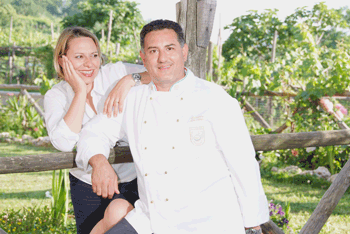
Anna and Sal de Riso
SdeR: I was born on November 28, 1966 into a family where I constantly breathed the aroma of sugar and sweets. However, I fell in love with this profession thanks to my mother Carmela who was a remarkable cook and pastry chef. She made all sorts of cakes at home. So in 1980 I decided to go to the public hotel management school in Salerno. During my school years and immediately afterwards I worked in the most prestigious hotels on the Amalfi Coast: Hotel San Pietro, Hotel Palumbo, Hotel Caruso in Ravello, and Hotel MirAmalfi. I usually worked in the kitchen as a chef, but I especially liked making sweets, which are made a bit differently in hotels from pastry shops. In 1987 I stopped working in hotels.
In 1989, at age 23, you decided that confectionary was your passion. How did this happen; what caused this realization?
SdeR: Even before I had my own business, when I worked in hotels, I worked extremely hard,as if the hotel belonged to me. I didn’t overlook the slightest detail. In the kitchen I never wasted supplies. All the managers and owners I worked for admired me. They noticed my passion for doing the best job possible. They realized that I was extremely responsible. Many hotel owners sought me out, but their offers never paid enough. Everyone underpaid me. At the beginning of my career this wasn’t a problem because I wanted to learn a trade. I wasn’t money-hungry. Starting from the bottom up has been extremely useful to me in learning how to run my own business. You can be a brilliant pastry-chef, but a terrible businessman!
Then the moment came. I had to go into business for myself either as a restaurateur or a pastry-chef, a trade that I loved more and more each day. So in 1989 I decided to open a tiny pastry laboratory because I could hook it up to my father’s business. He was well-known for his granite; his bar had expanded; it had tables outside shaded by umbrellas and was always busy especially in summer. I decided to make the sweets to go alongside his homemade ice creams and granite.
Over several years during the winter months I traveled to Paris and to Milan, in particular to Iginio Massari, to work as an apprentice. In this way I improved my techniques, learned about which products to use and which not, to invent sweets that had never been sold in this part of Italy before. From Massari I learned not only about flavor, but also about aesthetics, how to make a cake that was visually mouth-watering.
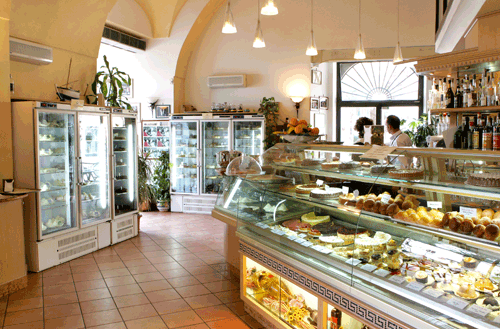
Pasticceria de Riso in Minori on the Amalfi Coast
My goal was to introduce new sweets to southern Italy. From the early nineties to this day, I’m considered an innovator in the world of pastries. Even if here in the south we have some delicious traditional sweets, I was the first to introduce mousses, cakes topped with fresh “exotic” fruits, but I always had deep respect for Campania’s local ingredients. This area of Italy has a rich variety of top-quality ingredients: hazelnuts from Giffoni, ricotta from here in Tramonti, white figs from Cilento, apricots from Mount Vesuvius, amazing wines from Benevento and Avellino to name just a few. I’ve always made use of these marvelous products. Let’s put it this way: my innovations bring out the best in the traditions of my home territory.
Who was your mentor?
SdeR: At the beginning of my career as a pastry chef I was self-taught for a few years. Then I understood that I needed to improve the quality of my sweets, so I entrusted myself to Iginio Massari whom I’d met in Paris. Massari is the greatest Italian pastry chef. He’s admired worldwide. I learned many new techniques from him but I also studied with other great “masters”: Eliseo Tonti, an Italian who’s lived many years in Switzerland, and Luigi Biasetto in Brussels. To keep up-to-date, I’ve taken several two-day full-immersion courses (12 hours a day), with Fulvio Scolari in Cremona. From all of these masters I learned new techniques which I then adapted to my own style. From Massari and Biasetto I also learned how to run a business. For example, in the year 2000, after I won a national competition, together with my colleague Gino Fabbri from Bologna I made the “Jubilee Cake” for Pope John Paul II. We presented it to the Holy Father in St. Peter’s Square.
What are the essential qualities for becoming a top pastry chef?
SdeR: Creativity, the exclusive use of genuine ingredients, curiosity, and a highly developed esthetic taste.
The secret of your success?
SdeR: The fact that I’ve never betrayed my clients. I’ve never lowered my standards when it concerned my ingredients. I’ve only ever used the highest quality products whether it be butter, olive oil, or chocolate. Even the liqueurs which I splash over my cakes, the various types of flour, and fresh milk are always top-quality.
Then I married and my children were born. As I began to invent new cakes, I named them for my family. My “Anastasia Cake” is named after my daughter; “Asia” after my niece.
Some of your other innovations?
SdeR: My first invention was “lemon profiterole.” At the beginning of my career as a pastry chef that was all I made. I sold them by the tons.
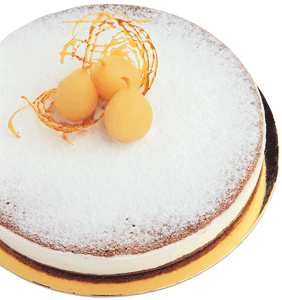
pear and ricotta cake
Then I transformed “tiramisu,” one of Italy’s most beloved desserts worldwide. I changed the ingredients: limoncello instead of coffee and lemon cream instead of mascarpone and zabaione.
Next my “Dolce di Amalfi” cake became famous because it can travel without refrigeration. It stays fresh for three months. Like limoncello tourists can easily carry it home.
My pear and ricotta cake is my warhorse. I invented it in 1998 using only local products: hazelnuts from Giffoni, ricotta from here in Tramonti, and pears from Agerola. Everyone has copied my recipe including giant food companies.
Among my other inventions over the years are: soffiato or a sort of soufflé of the renowned pastiera napoletana, a variation of this traditional Easter pie; its filling is a mousse. I also put eggplant in my cakes.
The importance of TV, of the program “La Prova del Cuoco” (Testing the Chef), in your success?
SdeR: I’ve always been deeply involved in my self-promotion. I’ve won many national and international competitions and received numerous honorary citizenships. I received the “ampollo d’oro” in 2007 for promoting the use of extra-vergine olive oil in pastry making.
Obviously my exposure on television has been an enormous help. You know just as well as I do that “entering into the homes” of so many people these days can make you famous even if you don’t know how to do anything, if you have no special talent. All you need to do is be a contestant on the program: “L’isola dei famosi.”
Which of your many sweets does the public like best?
SdeR: My three most popular sweets are my ricotta and pear cake, followed by my “Delizia al
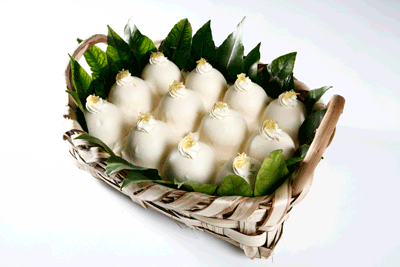
Delizia al Limone
limone,” followed by my “Anastasia Cake.”
You named one of your cakes “Donna Sophia” after Sophia Loren. Do you know her well? If so, what is she like out of the limelight?
SdeR: I only met her once at a gala evening for 800 guests. It was in February 2008, when Sorrento gave her honorary citizenship. I made the dessert, “Delizia all’arancia” with a heart of chocolate. She thanked me for my sweet and we exchanged a few sweet nothings. Nothing more.
Of your products, what type is the best-seller?
SdeR: Cakes. In addition to our stores, we supply our cakes to lots of restaurants all over Italy. Every Friday trucks refrigerated at -18C leave Tramonti filled with our products ‑ even with wedding cakes made on Thursday for Saturday’s celebration. Our best clients are in the Veneto and in Friuli/Venezia Giulia where we have excellent contacts with wedding organizers. We make the rest of our products from Monday through Thursday and deliver them on Friday and Saturday. I work through distributors so I don’t even know who all my clients are. Sometimes I eat at a restaurant and find my desserts on the menu without knowing that the restaurant is my client.
Can you explain the origin of your logo?
SdeR: The inspiration for my logo came during a visit with my graphic designers to an ancient Roman villa in Minori built during the first century A.D. A graffito on a wall there inspired its design. The name Sal is an abbreviation of Salvatore. My wife comes from Rome, where they always chop off the ends of names. She’s always called me Sal. We met on the beach in Minori where she was vacationing.
Besides your shops on the Amalfi Coast and in Rome your products are distributed in St. Petersburg. Why Russia? Do you have plans to distribute elsewhere?
SdeR: It wasn’t my decision. Some Russians came to the Amalfi Coast on vacation. They tasted my products. When back home, they contacted me and opened a beautiful shop for my products only in St. Petersburg. I’m negotiating now, with an Italian, a distributor, who lives in New York and wants to sell my products to Italian restaurants there.
I’ve read that people are cutting down on sweets, that they don’t eat dessert in restaurants or buy sweets to take home. Do you think this is due to the worldwide financial crisis or a growing concern about obesity? Has it affected your business?
SdeR: Since you want to know my opinion, I think that people are ordering fewer desserts in restaurants because, if they have to pay five Euros for a slice of cake that’s not even good, they probably won’t bother to order it. People don’t go to pastry shops on Sundays after church for the same reason: the pastries are too expensive and not even good.
My company isn’t suffering in the present crisis. This year our profits have grown by 15% over last year. Twenty-eight people work here and our turnover is three million Euros. A 15% increase in our profits over last year is extremely significant.
You have won a long list of awards and international honors; which one gave you the greatest satisfaction?
SdeR: All of them have given me great satisfaction, but the most special was my meeting with Pope
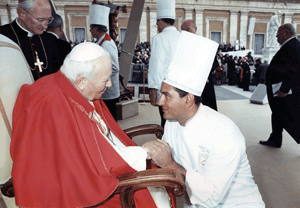
Sal with Pope John Paul
John Paul II. Then I received the blessing of being born and living a lucky life, of having two healthy children. God’s gift of having children is the greatest aspiration a person can hope for; it’s life’s greatest reward. My son is named Antonio after my father; my daughter Anastasia, a name that both my wife and I liked.
What aspect of your work do you enjoy the most?
SdeR: That my clients come back, that they compliment me, send me favorable emails, thank me. These aspects gratify me the most. We work really hard to make our sweets, especially our wedding cakes, and distribute them all over Italy and on request even worldwide. Without a doubt, when a bride or another client telephones to thank me for my efforts and a splendid product, I’m filled with joy.
Another aspect of my work that I love is when I invent a new sweet which becomes a best-seller. That’s the reward for my creativity.
The least?
SdeR: When my clients don’t pay me. There should be a law that forces people to pay at once because at the end of the month a business like mine has to pay its workers, its suppliers, and its distributors. If small businessmen including myself don’t get paid what we’re owed on time, we have serious financial problems.
You’ve written two books “I Dolci del Sole” (Sweets under the Sun)(2008) and “I Dolci in Famiglia” (My Family’s Sweets)(2009); have they been translated? Are you writing a third book?
SdeR: Both my books were published by Rizzoli. Rizzoli owns their rights and it’s up to Rizzoli whether to translate them or not. So far they haven’t been translated. Rizzoli wanted to package them in a box together for sale at Christmas, but then discarded the idea.
At the moment I’m not writing a third book. Rizzoli has informed me that the first two are still selling very well this year: “I Dolci del Sole” 40,000 copies and “I Dolci della Famiglia” around 25,000.
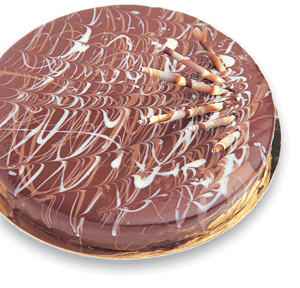
Anastasia Cake
Up to now we talked about Sal De Riso the pastry chef; I’d like to know more about you as a person. For example, what’s your favorite sweet?
SdeR: Chocolate. Any sweet or cake made with chocolate. I never say “no” to my “Anastasia Cake” or “Black Forest Cake.” I like other sweets according to its occasion or its holiday.
A sweet you don’t like?
SdeR: I don’t like ginger so any sweet made with ginger.
Your favorite ice cream flavors?
SdeR: Lemon and hazelnuts because here on the Amalfi Coast these ingredients are the best in the world.
Chefs are known for having collections of fast cars, motorcycles or watches. What about you?
SdeR: Cookbooks.
You are called “Italy’s most famous pastry chef; other pastry chefs that you admire?
SdeR: Leonardo di Carlo, Luigi Biasetto, and all my colleagues who are members of the Accademia dei Pasticcieri (The Academy of Pastry-Chefs). They’re all highly qualified professionals. We are constantly exchanging recipes and techniques.
If you hadn’t become a pastry chef, what profession would you have chosen?
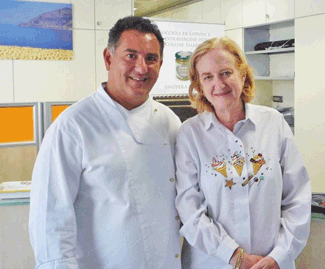
Salvatore de Riso and Lucy Gordan
SdeR: No other. It was my destiny to become a pastry chef. Creating sweets equals creating sweetness which equals inspiring smiles and happiness because, when you eat a sweet, it’s certainly to celebrate a happy occasion. When there’s a party, there’s a feeling of well-being; something happy has happened. Eating a sweet is always a moment of joy.
& & &
